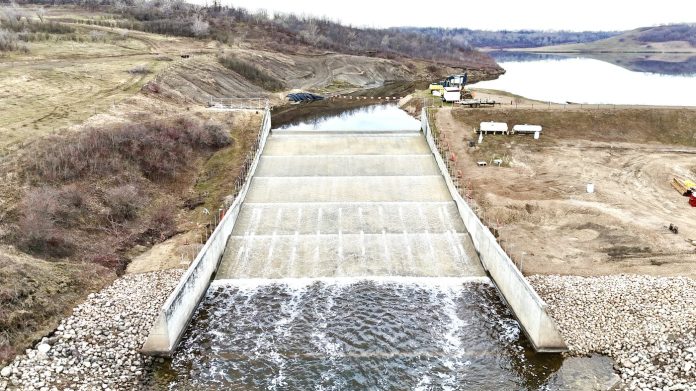
Ryan Kiedrowski, Local Journalism Initiative Reporter, The World-Spectator
The $8.8 million upgrade to the Moosomin Dam that began last fall is officially complete—on time and within budget.
“As of April, the installation of the slab on the spillway is complete and the spillway is operational in time for spring runoff,” said Patrick Boyle, spokesperson with the Water Security Agency. “Over the spring and summer, we will complete work on finishing remaining earthworks, installing fencing and signs and anticipate to be complete by this summer.”
A large part of the upgrade was a 300 mm thick concrete slab that Boyle says will “increase the weight of the spillway, strengthening it against movement which in addition to the existing drainage system will protect the structure.”
“Everything’s pretty much back in place,” echoed Moosomin Mayor Larry Tomlinson. “We had the riparian gate open for quite a while to keep the water down, and it is now closed. The water is going over the spillway approximately about 10 inches deep.”
A coffer dam was installed above and below the dam, and Tomlinson confirmed that those structures have been removed.
Another concern was aeration of Moosomin Lake as water levels were lowered by a total of 45 cm since last July. This was done to not only reduce the number of mid-winter releases due to potential snowmelt, but also prevented thin ice in the downstream channel and on the reservoir.
“The oxygen level stayed pretty good,” Tomlinson was happy to state. “Chris Davidson and I did check some oxygen in the winter, and I think the lowest that we saw was down to around six or 6.4, which is really good. We don’t really worry until it gets down around four or less. All the ice is off as of yesterday, and the fish all survived well, as near as we can tell.”
With the last maintenance work being completed, public access to the area will look much the same as before the project began.
“On the bottom side, that was locked before and it’s going to be permanently locked now, same as it was before,” Tomlinson said. “They got a little bit of roadwork to do, I think they’re going to touch up the road below and the road above so it’s left in good shape.
“As far as the top end, it’ll be open the same as it was, I’m sure,” he continued. “Unless they decide to close it, I know there’s a little bit of fence work to do, but I can’t answer that question; whether you’re going to be able to go across the top or not, or whether it’s going to be locked off because it was at one time years ago locked off.”
The WSA is working on more than 60 projects from now through to next year with $42 million set aside for the fiscal year.
“Water infrastructure is a major priority for our government, as it supports and provides water for domestic, industrial, recreational and agricultural purposes,” Minister Responsible for the WSA David Marit said. “Our water management structures are vital to help us meet increasing water demands for a growing province.”
The Moosomin Dam project was one of six major projects that received a combined $17 million piece of that larger funding commitment, including projects on the Craven Dam (bulkheads and lift station), Buffalo Pound Dam (emergency spillway upgrades), the East Side Pumpstation at Lake Diefenbaker (substation upgrades), and Gardiner Dam (two projects related to public and operator safety).
Other projects across the province are planned in the communities of Cumberland House, Meadow Lake, Outlook, Craik, Cypress Hills, Swift Current, Lafleche-Val Marie, Humboldt-Watrous, Fort Qu’Appelle, Craven, Regina, Saskatoon and Estevan.
“These projects will be critical to ensure we can maintain resilient infrastructure that protects our communities and allows us to manage water during floods and droughts,” Marit said.
The Saskatchewan Urban Municipalities Association also stressed the importance of the maintenance work, especially as it relates to extreme levels of water.
“SUMA and the cities, towns, villages, resort villages and northern municipalities that we represent, appreciate WSA’s investment in upgrading water infrastructure,” SUMA President Randy Goulden said. “These structures are crucial to ensuring that our communities can enjoy a sustainable supply of water, especially during times of drought.”
Over the past 17 years, the WSA has invested more than $280 million in maintenance, upgrading and rehabilitation work on water management structures around the province. They own and operate 72 dams and control structures, plus a canal system and conveyance channels across Saskatchewan.

